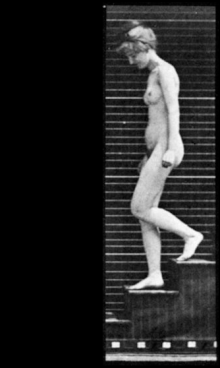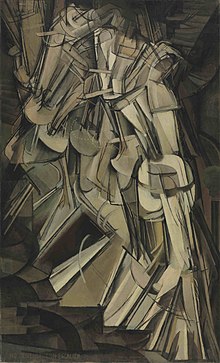Naked Woman Climbing a Staircase
| Naked Woman Climbing a Staircase | |
|---|---|
| French: Femme nue montant l'escalier, Catalan: Dona nua pujant l'escala | |
 | |
| Artist | Joan Miró |
| Year | 1937 |
| Type | Drawing |
| Dimensions | 78 cm × 55.8 cm (31 in × 22.0 in) |
| Location | Fundació Joan Miró, Barcelona |
Naked Woman Climbing a Staircase (originally in French Femme nue montant l'escalier) is a drawing done with pencil and charcoal on card made by Joan Miró in 1937. It is part of the permanent collection of the Fundació Joan Miró in Barcelona.[1]
History
[edit]
Miró created Naked Woman Climbing a Staircase during the Spanish Civil War. He was living in Paris when he started to attend life drawing classes at the school of the Grande Chaumiere. Miró returned to constructing the human figure to represent the drama that was then taking place in Catalonia. This feeling can be made out in the shapes used to draw this tortured nude woman climbing a staircase.[2] Other works of this period include Still Life with Old Shoe and Aidez l'Espagne.[3]
Description
[edit]
According to the Joan Miró Foundation, "Miró's despondency brought about by the moral tragedy of the war can be seen in the violent metamorphosis of the figure, in her heavy limbs and in the effort involved in climbing."[4] At the top right is a kind of window or box where light rays can be seen entering the room. The woman is using her right arm to try to grab a ladder – this was a symbol that Miró used in several of his works to represent evasion or escape. The external genitals of the woman are similar to those of the woman in Man and Woman in Front of a Pile of Excrement as they are exaggerated in size.[5] This work is said to be related to Marcel Duchamp's 1912 painting Nude Descending a Staircase, No. 2, although here the woman is ascending. The distortion and effort of the figure are interpreted as mirroring the Spanish Civil War.[4] Duchamp's painting was not original; it alluded to the earlier photographs by Eadweard Muybridge[6] which were amongst the first to record animal locomotion. Miró first saw this work by Duchamp in 1912, during the Cubist art exhibition held at Galeries Dalmau in Barcelona.[7][8]
Muybridge's idea of a woman on a staircase caught the imagination of not only Duchamp and Miró but also Miró's contemporary Salvador Dalí who created a homage to Duchamp's painting. His model was also shown ascending the stairs[9] like Miró's subject.
Exhibitions
[edit]| Start | End | Exhibition | Place | City | Ref |
|---|---|---|---|---|---|
| 1964 | 1964 | Tate Gallery | London | [10] | |
| 1964 | 1964 | Kunsthaus Zürich | Zurich | [10] | |
| 20 September 1978 | 22 January 1979 | Dessins de Miró | Centre Georges Pompidou | París | [11] |
| 1 June 1980 | 31 October 1980 | Palacio de Velázquez | Madrid | ||
| 21 November 1986 | 1 February 1987 | Kunsthaus Zürich | Zurich | [12] | |
| 14 February 1987 | 20 April 1987 | Städtische Kunsthalle | Düsseldorf | [12] | |
| 24 November 1988 | 15 January 1999 | Impactes. Joan Miró 1929–1941 | Fundació Joan Miró | Barcelona | [13] |
| 3 February 1989 | 23 April 1989 | Joan Miró: Paintings & Drawings 1929–1941 | Whitechapel Gallery | London | [14] |
| 4 July 1990 | 14 October 1990 | Maeght Foundation | Saint-Paul-de-Vence | [15] | |
| 20 April 1993 | 30 August 1993 | Fundació Joan Miró | Barcelona | [16] | |
| 6 October 1993 | 11 January 1994 | Museum of Modern Art | New York | [17] | |
| 11 February 1995 | 17 April 1995 | Städtische Kunsthalle | Düsseldorf | ||
| 12 May 1995 | 16 July 1995 | Kunsthalle Wien | Vienna | ||
| 28 July 1995 | 22 October 1995 | Galleria d'Arte Moderna e Contemporanea de Verona | Verona | ||
| 26 February 1996 | 5 May 1996 | CCCB | Barcelona | ||
| 7 June 1997 | 11 November 1997 | Miró, ceci est la couleur de mes rêves | Fondation Pierre Gianadda | Martigny | [18] |
| 15 May 1998 | 30 August 1998 | Joan Miró. Creator of new worlds | Moderna Museet | Stockholm | [19] |
| 18 September 1998 | 10 January 1999 | Joan Miró. Creator of new worlds | Louisiana Museum of Modern Art | Humlebæk | [20] |
| 4 July 2000 | 5 November 2000 | Maeght Foundation | Saint-Paul-de-Vence | ||
| 23 October 2001 | 27 January 2002 | Rèquiem per les escales | CCCB | Barcelona | [21] |
| 6 March 2002 | 24 June 2002 | La Révolution surréaliste | Centre Georges Pompidou | Paris | [22] |
| 20 July 2002 | 24 November 2002 | Kunstsammlung Nordrhein-Westfalen | Düsseldorf | ||
| 25 November 2004 | 6 February 2005 | Joan Miró. Arquitectura d'un llibre | Fundació Joan Miró | Barcelona | [23] |
| 25 October 2007 | 27 January 2008 | Joan Miró. 1956–1983 Sentiment, emoció i gest | Fundació Joan Miró | Barcelona | [24] |
| 14 April 2011 | 11 September 2011 | Miró. | Tate | London | [25] |
| 15 October 2011 | 18 March 2011 | Miró i l'escala de l'evasió. | Tate, Fundació Joan Miró | London & Barcelona | [26] |
| 6 May 2012 | 12 August 2012 | National Gallery of Art | Washington | [26] |
2011 exhibition
[edit]The exhibition L'escala de l'evasió that opened in October 2011 was supported by access to Wikipedia using QRpedia codes that allowed access to visitors in Catalan, English and several other languages.[27]
Notes
[edit]- ^ "Information about the work at the museum site". 2011. Retrieved 20 August 2011.[permanent dead link]
- ^ Works by Joan Miró. Joan Miró Foundation. 1988. Ediciones Polígrafa.
- ^ "The Tate Modern discovers the most political Miró". Diario de Mallorca (in Spanish). 2011. Retrieved 24 September 2011.
- ^ a b "A New Approach To Joan Miró" (PDF). Joan Miró Foundation. p. 41. Archived from the original (PDF) on 20 June 2011. Retrieved 5 November 2011.
- ^ Clavero 2010, p.72-73
- ^ Tomkins, Calvin (1996). Duchamp: A Biography. U.S.: Henry Holt and Company, Inc. ISBN 0-8050-5789-7.
- ^ Surrealisme a Catalunya, 1924–1936: de l'amic de les arts llogicofobisme (in Catalan). Polígrafa. 1 August 1988. p. 17. ISBN 978-84-343-0539-7. Retrieved 5 November 2011.
- ^ Rosa Maria Malet; Joan Miró (1993). Joan Miró. Edicions 62. p. 19. ISBN 978-84-297-3568-0. Retrieved 5 November 2011.
- ^ Judovitz, Dalia (2010). Drawing on art: Duchamp and company. Minnesota Press. p. 147. ISBN 9780816665297. Retrieved 5 November 2011.
- ^ a b Jacques Dupin; Joan Mirâo; Ariane Lelong-Mainaud (2002). Joan Miró: catalogue raisonné : paintings. Daniel Lelong. Retrieved 24 September 2011. cat num 151
- ^ cat. núm. 145, repr. p. 70
- ^ a b cat. nº 108 repr
- ^ cat. nº 56 repr. p.88
- ^ cat. repr.
- ^ cat. nº 102, repr. p. 343
- ^ cat. nº 147 repr. p.343
- ^ cat. repr. p.226
- ^ cat. nº 40 repr. p.95
- ^ cat. nº 102 repr. p.113
- ^ cat. nº 84 repr. p.66
- ^ Agustí, Fancelli (25 October 2001). "Óscar Tusquets entona un réquiem emocionado por la escalera". El País (in Spanish). Retrieved 20 August 2011.
- ^ "La Révolution surréaliste. Fitxa de l'exposició" (PDF) (in French). 2002. Archived from the original (PDF) on 18 November 2006. Retrieved 20 August 2011.
- ^ "Joan Miró. Arquitectura d'un llibre". Fundació Joan Miró. 2004. Retrieved 29 September 2011.
- ^ "Joan Miró. 1956–1983 Sentiment, emoció i gest". Fundació Joan Miró. 2007. Retrieved 29 September 2011.
- ^ "Miró i l'escala de l'evasió. Fitxa de l'exposició". 2011. Retrieved 20 August 2011.
- ^ a b "Miró i l'escala de l'evasió. Fitxa de l'exposició". Fundació Joan Miró. 2011. Retrieved 20 August 2011.
- ^ Photo at opening day of the exhibition, 15 October 2011
References
[edit]- Clavero, Jordi.J (2010). Fundació Joan Miró. Foundation's Guide. Barcelona: Polígrafa. ISBN 978-84-343-1242-5.
- Joan Miró (1988). Obra de Joan Miró: dibuixos, pintura, escultura, ceràmica, tèxtils. Fundació Joan Miró-Centre d'Estudis d'Art Contemporani. Retrieved 5 October 2011.
- Jaques Dupin – Ariane Lelong-Mainaud. Joan Miró. Catalogue raisonné. Drawings I 1901–1937, 2008. Daniel Lelong and Successió Miró
